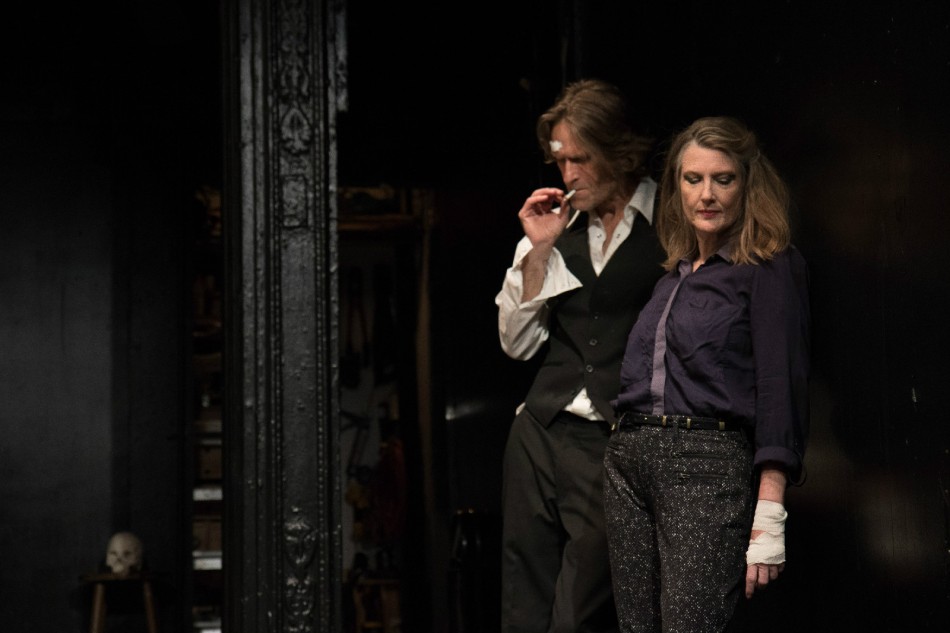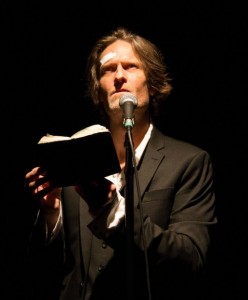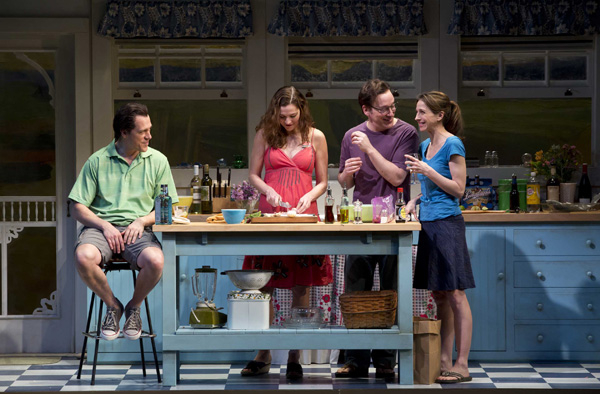by JK Clarke
Your average theatergoer rarely has the occasion for an in-depth study of a single scene in a particular play the way an actor, director or dramaturge might. But doing so, especially with Shakespeare’s plays, provides a fascinating opportunity to understand both the play and certain characters in great detail. Michael Laurence’s terrific new two-hander, Hamlet in Bed (now playing at the Rattlestick Playwrights Theater in the West Village) does just that.
Laurence also stars as “Michael, like it says in the program. I’m an actor, I guess. That’s obvious I guess. Anyway. This play. I wrote this play,” he tells us, with utter disregard for the fourth wall. But the fourth wall slowly starts to build back up as the play moves along and Michael becomes immersed in the moment. Hamlet in Bed is a play within a play, he tells us. But it might be a play within many plays. Michael is a typical Greenwich Village character: a gaunt, late 30s (but older looking) guy in a stylish black suit, white bandage above his eye and very junkie chic. He’s an actor, raised as an orphan, with a deep love of Shakespeare. Hamlet in particular. And he’s very fond of Act III, Scene iv, in which Hamlet and his mother, Queen Gertrude, have a contentious heart to heart. Michael believes the entire play started from that point and spun out in both directions. Hamlet, he thinks, is more about a filial relationship than anything else. He might be right. But that’s the great thing about Hamlet. It’s open—very open—to all sorts of interpretations.
Michael goes on to tell us that he was browsing a bookseller’s table on Sixth Avenue when the vendor pointed out a young woman’s diary from the mid 1970s. One entry reveals she is an actress playing Ophelia in a production of Hamlet. For seemingly legitimate reasons, Michael has an epiphany that the diary may belong to his birth mother, a woman he has never met and whose actual identity is unknown to him. With a little internet sleuthing, he manages to track down the diary’s original owner, Anna, and follows her for a day or two. He becomes more certain than ever that she is his mother. Anna (Annette O’Toole) is a rambunctious alcoholic who’s routinely tossed out of bars for bad behavior. She’s an “old girl,” a woman who hasn’t relinquished her youth and dresses (costumes: Jessica Pabst) a little too young for her age, with tight rocker pants and a stylish, contemporary top. In an attempt to appear twenty years younger, she wears thick eyeliner the way a 14-year-old girl would wear it to look 10 years older.
The bulk of the play winds around Michael’s ruse of casting Anna (who hasn’t acted since the 70s) in an ersatz production of Hamlet, in which he plays the forlorn prince. They rehearse Act III Scene iv repeatedly, getting acquainted with one another and allowing him to know his “mother.”
This is dangerous territory. If, as a writer, you’re going to intertwine your dialog with that of arguably the best writing in the history of theater, it had better be good. Really good. Or somehow complementary. Yet, Laurence, O’Toole and director Lisa Peterson pull the whole thing off beautifully. Laurence’s writing, often in verse, dovetails nicely with the Bard’s (large sections of which are recited in the play), and always respectfully. He’s funny, self-aware and likeable both on the page and on the stage. O’Toole, too, is magnificent. Her Anna, who could be a one-dimensional drunk in a lesser play, is so much more, belying the fact that she’s an unsuccessful actor who ended up in a crappy office job. Hers is an oft-told tale in New York City. We are sympathetic to her rage and feel helpless at her lack of direction; yet, when she has to step up and handle Michael, we see strength, grace and a little maternal tenderness (legitimate or not). And the production is pushed along by Scott Zielinski (lighting) and Dave Tennent’s (projection) design elements that expand the stage and bring the Village alive sometimes with snow, or other times with shadows that feel authentically New York and authentically Greenwich Village.
In the original, Hamlet’s scene with his mother in her chambers is often overshadowed by the murder of Polonius. But it’s a scene that’s so much more than that (Polonius, in fact, lies—presumably—in a pool of his own blood for more than half the scene; how it doesn’t flood the stage is ponderous). It’s a remarkably in-depth study of the complicated dynamic between mother and son. Laurence realizes this and his gift to us is the intense study of those two lost characters through the eyes of two other extremely lost characters who may or may not be mother and son. Laurence has artfully taken an already complex moment and tweaked it just enough to capture our attention to and interest in the scene in ways we never could have expected.
* Photos by Tristan Fuge
Hamlet in Bed. Through October 25 at Rattlestick Playwrights Theater, 224 Waverly Place (between West 11th and Perry Streets). www.rattlestick.org

























